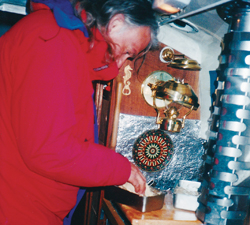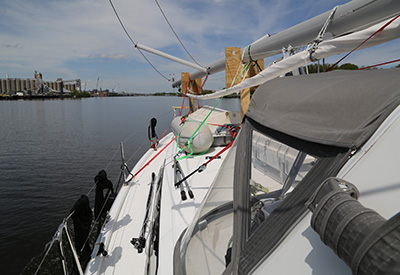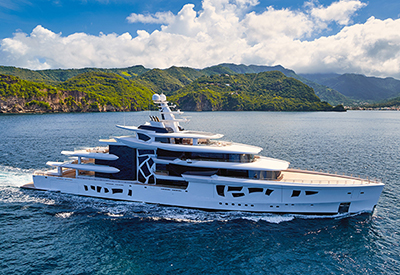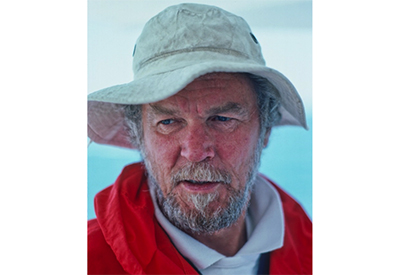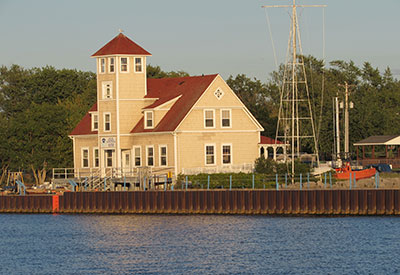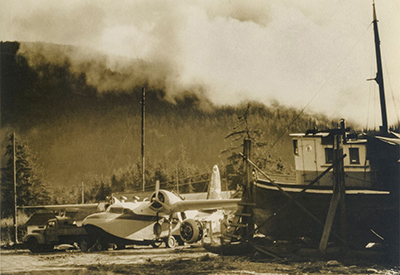The Voyage of Free Spirit V: Northbound!

Our first summer cruise aboard Free Spirit V changed our lives and introduced us to places and challenges we could never have imagined.
Rob and I were complete novices when we bought our first boat, Free Spirit V, a 1991 Kadey Krogen 42 foot full-displacement trawler, in December 2010. Still, we wanted to follow friends north for a 10-week cruise the following summer. Bringing our knowledge and skills up to standard would mean a lot of winter cruising.
Between December and the end of May 2011, with our reluctant standard poodle, Blue, in tow, we clocked almost 100 engine hours, and many of them weren’t pretty. Early entries in our log betray our inexperience and anxiety: “Why is the battery low?” “Whitecaps+++” and, “Things are crashing around inside boat.”
In fact, our “first hundred” included a wide array of mishaps. Like the time a gust of wind caught us on our first trip to the fuel dock and pushed us into a particularly magnificent and towering yacht. I watched helplessly as the big boat’s anchor shaved a slice of teak from our rail like it was parmesan cheese. The burly permanent skipper on the towering yacht ran  to “greet” me as I did my best to fend off his boat. Prepared for an earful, I almost cried when he was as kind and helpful as could be. Miraculously, there was no harm to the other boat and, instead of exchanging insurance information, we were offered a tour.
to “greet” me as I did my best to fend off his boat. Prepared for an earful, I almost cried when he was as kind and helpful as could be. Miraculously, there was no harm to the other boat and, instead of exchanging insurance information, we were offered a tour.
After our first crossing of the Strait of Georgia, we attempted a tricky docking in a busy North Vancouver marina. Current and wind conspired against us (it’s never our fault!) and we ended up with our bow pointing opposite to our intended direction and drifting sideways toward another boat. Friendly folks on that boat enthusiastically invited us to fender up and crash into them. With fenders in place, we came alongside gently and navigated into our slip―albeit from a different direction than we had planned.
After some reflection and a few glasses of wine, we concluded that we would only succeed in this venture if we were willing to learn from our failures, however public and spectacular they might be. This would take mental fortitude and  mustering that would be the real challenge. It was a trial made easier by the unfailing kindness of other boaters who, in addition to giving us helpful advice, shared their own horror stories.
mustering that would be the real challenge. It was a trial made easier by the unfailing kindness of other boaters who, in addition to giving us helpful advice, shared their own horror stories.
New friends Bill and Eileen also own a 42ʹ Krogen, Ceilidh I. With their amphibious yellow lab, Casca, they’ve explored the central BC coast every summer for years. They invited us to follow them the coming summer, leaving in the third week of June. Our only reservation was that we might be a burden, slowing them down or holding them back. That concern, and our constant fear of the unknown, motivated us to prepare systematically. With Bill and our instructor, we created lists of the skills and equipment we would need. Eileen offered sound advice about provisioning. We practiced mapping out routes, towing the dinghy, dropping anchor and docking, docking, docking. By April 2011, we both passed our Canadian Yachting Association Basic Power Boating exams and Rob acquired his VHF operator’s licence. On the basis of our instruction, testing and hours logged, our insurer granted coverage that permitted us to go all the way to Alaska. I remember thinking: If they think we can do it, we must be able to,  right? We set our sights somewhat short of Alaska and aimed to get as far as Ocean Falls.
right? We set our sights somewhat short of Alaska and aimed to get as far as Ocean Falls.
In May 2011, we redoubled our efforts to get the boat properly equipped and provisioned. We installed a new barbeque and freezer on the flybridge. We took the surprisingly heavy life raft in for repacking. We had a custom towline made for our tender, a 13ʹ Boston Whaler. We installed a large stainless-steel reel on the flybridge to hold 600ʹ of stern line. Hmmm, a stern line. We had never used one of those. One more thing we’d have to learn on the fly. We made unending lists of groceries and sundries.
Soon enough, the third week of June was upon us and there could be no more preparation. We bought our first-ever fishing licences. We parked our car for the summer. Blue made one last-ditch attempt to escape, but soon the three of us were underway.
 On Our Own
On Our Own
Our first summer aboard Free Spirit V drew an indelible line in our lives, marking our introduction to places and experiences we could not have imagined and revealing things about ourselves that we did not already know.
We were to join Bill and Eileen across the Strait of Georgia at Gibsons Landing, a three-day trip for us from Sidney. Our first night we were left on our own at anchor in Clam Bay, between Thetis and Kuper Islands. We had never anchored overnight, and the prospect was unnerving. We bit the bullet, did what we had been taught to do and settled in. Kuper Island belongs to the Penelakut First Nation, and at dusk we noticed a fellow in a canoe paddling nearby. Gilbert Smith, a resident of Kuper Island, stopped by to show us his lovely yellow cedar carvings. We purchased a carving of a salmon, a good omen for the weeks to come, we hoped.
 Two days later, we left Gabriola Island to cross the strait and decided to tow the Whaler. I let the line out while Rob steered ahead. To my horror, the loop on each cleat slipped gently off into the water and I watched as we left our tender behind. A virtual man-overboard exercise enabled us to retrieve the dinghy. We laughed uneasily and headed for Gibsons where we had a delightful dinner with Bill and Eileen and reviewed where they would lead us the following day.
Two days later, we left Gabriola Island to cross the strait and decided to tow the Whaler. I let the line out while Rob steered ahead. To my horror, the loop on each cleat slipped gently off into the water and I watched as we left our tender behind. A virtual man-overboard exercise enabled us to retrieve the dinghy. We laughed uneasily and headed for Gibsons where we had a delightful dinner with Bill and Eileen and reviewed where they would lead us the following day.
At spectacular Jedediah Island we dropped anchor and I climbed a steep, brush-covered rock to secure our first stern tie. With only modest scrapes and bruises to show for my climb, we were set. We hiked around the unusual and visually stunning island, seeing feral goats, old-growth forest and the original homestead.
For the first few weeks, we felt like aliens; almost every task or experience was new. This included heading out under a dusky sky to drop our first prawn trap in Malaspina Strait and, the following morning, delightedly pulling it up to find 20 very large prawns.
 We had read and heard so much about Desolation Sound that I wondered if it could live up to the hype. It really does. The approach is breathtaking and we couldn’t believe we were finally seeing it. And from our own boat! We headed for Roscoe Bay where we triple-checked our tide tables before we traversed a sandbar at just the right time to enter this stunning bay. That night, we enjoyed the bounty of our prawn trap—17 prawns (like socks in a dryer, three went missing while they cooked…) with orzo, green peppers, feta and white wine. What more could we want!
We had read and heard so much about Desolation Sound that I wondered if it could live up to the hype. It really does. The approach is breathtaking and we couldn’t believe we were finally seeing it. And from our own boat! We headed for Roscoe Bay where we triple-checked our tide tables before we traversed a sandbar at just the right time to enter this stunning bay. That night, we enjoyed the bounty of our prawn trap—17 prawns (like socks in a dryer, three went missing while they cooked…) with orzo, green peppers, feta and white wine. What more could we want!
A couple of days later we decided to push on. The only safe time to exit Roscoe Bay (and clear the bar) was an uncivilized 0530 hours. We rose at 0500, raised the anchor and exited on time, then promptly dropped anchor on the other side of the bar and, as Bill shouted “good night” from his boat, we all went back to bed. At a more suitable hour, we steamed on to Tenedos Bay.
Our time here was enhanced by Eileen’s historical connection to this area. She loaned me her copy of Desolation Sound, A History by Heather Harbord; Chapter 12, “Theodosia Inlet and Tenedos Bay, Ultimate Wilderness for the Palmers,” details her ancestors’ journey to and homesteading in this rugged area.
Through the Rapids
After a night at anchor near Squirrel Cove on Cortes Island, we traversed the Yuculta Rapids, Gilbert Passage and Dent Rapids to reach Frederick Arm. Rob, Bill and I each did separate calculations of the currents and met to compare notes. Happily, we were on the same page―it is never comforting to need to persuade someone of the safest time to traverse rapids.
Our classroom instruction taught us that we should traverse each of these rapids at or within 15 minutes of slack, but that would not be possible if we were going to get through all three in one go. Instead, we would enter the first set 60 minutes before slack (as various publications and Bill’s prior experience recommended) in order to hit the worst spot, Devil’s Hole, at slack. Expecting that our boat would be pushed around, Rob and I remained calm when it actually happened.
We picked up our first guests in Port McNeill and spent a few days in the Broughtons. A real highlight was Alert Bay with its colourful houses, powerful historic totem poles, the acclaimed U’Mista Cultural Centre, and the haunting St. Michael’s Residential School. Some of the places we visited felt special and we knew we’d return. Alert Bay was one of those places.
Unexpected hazards lurked everywhere. Even at the dock. Back in Port McNeill, we said goodbye to our guests and the next morning I took Blue for an early walk. It was cold and grey and there was no one about. Blue skipped happily across the plank Rob built to connect our swim grid to the dock, which enabled Blue to exit from the transom (our only door). Bundled up in sweatpants, a down jacket and a toque, I followed. Returning to the boat, I encouraged Blue to “walk the plank” and get back onboard. When he was safely aboard, I stepped on the plank. It turned sideways and dumped me in the water. Both dock and swim grid were too high for me to easily pull myself out. Fortunately, Rob heard the splash and quickly emerged from the galley. He deployed our newly-installed and very expensive re-boarding ladder on the swim grid. It is meant for situations just like this―but it didn’t work! Every time I stepped on the lowest rung, the entire ladder folded up under the boat, taking me with it. While I treaded water, Rob and I discussed why it did not work. I also warned him: “Do not step on the plank.” Do. Not. Step. On. The. Plank. Of course, he did step on the plank and immediately plunged into the water beside me. “Now we’re screwed,” I said calmly while I continued to tread water.
Rob grabbed onto something with one of his very long arms and pulled himself onto the swim grid. Then he held one of my arms while I threw a leg onto the swim grid. I rolled, seal-like, onto the swim grid where I lay, face down, for several minutes and told Rob not to touch me. After hot showers, coffee and coming to terms with the fact that I just destroyed yet another Blackberry, we laughed about it. However, it was sobering to see how dangerous it is to fall in the water, even at a dock!
Around Cape Caution
It was a dark and stormy night in Blunden Harbour where we waited to round Cape Caution. I learned that Captain George Vancouver named the cape for its potential danger, having narrowly avoided disaster there. Okay, but he didn’t have a chartplotter, I told myself. In teeming rain, we gathered on Ceilidh I to review coordinates for the next day’s route. It helped tremendously that Bill and Eileen had made this journey a number of times; nevertheless, they are not complacent about its dangers and treat every major passage with fresh respect.
Neither of us slept well and at 0400 I heard Rob tune in the marine weather in the pilothouse. The four of us had agreed that we would not go unless wave height at Western Sea Otter Buoy was one metre or less and the wind was less than 15 knots. The conditions were right. At 0545 Bill called us on the radio and we decided to get going. By 0630 we were drinking coffee and eating breakfast underway. We exited the foggy, rainy harbour and noticed that all the other boats remained anchored and dark. Hmmm.
Visibility was almost nil, but from the pilothouse I saw hundreds of marbled murrelets hanging out on the water’s surface, hardy little souls. The first two hours remained foggy but the sea was relatively calm. Then we hit three-foot swells as we passed Slingsby Channel. If this was as calm as it gets out here, we wouldn’t want to see it any rougher. In the swells, Rob’s engine checks were punishing. When we finally couldn’t wait any longer for something to eat, I sprinted to the galley, slapped peanut butter between slices of bread and grabbed a few apples. Nearly seven hours after we raised our anchors, we dropped them again in an unnamed spot that Eileen dubbed “Perfection Cove.” We were in Rivers Inlet!
For the next four weeks, we took our time exploring Rivers Inlet, Fish Egg Inlet and Fancy Cove in Lama Passage, where we holed up for three days to avoid bad weather. Our three days in Fancy Cove were memorable because it rained the entire time, and there was little to do but fish and trap crabs (with wolves in the area, we took the dogs only to tiny islets). I spent the days reading and writing, taking photographs, cooking and baking. To my great amazement, I loved every minute of it. I liked knowing Eileen was nearby on Ceilidh I, while Rob and Bill were out fishing. In the evenings, we often gathered for a potluck dinner on either boat. It was peaceful.
Ocean Falls was our farthest destination; we toured the virtual ghost town and met the few friendly residents still there. We dined with local loggers in the kitchen at the boarding house, visited the “museum” and shared the road with a resident bear. We saw the magnificent dam, filled our tanks with sparkling water and enjoyed the huge local Dungeness crab. Once a seemingly bucolic little boomtown with an Olympic-size swimming pool, most of the town, including a large hotel, was now deserted and in disrepair.
Homeward
We started the long journey home. Averaging about seven knots, we had weeks of travel ahead of us. The trip home was tremendous; we were in a new zone by then and feeling more competent each day.
Before we rounded Cape Caution on our return south, humpback whales in Rivers Inlet provided one of the summer’s highlights. Feeding all around us, they corralled pilchard in tight balls using a curtain of bubbles and then swam up from below, their huge mouths agape at the surface. We anchored once again in “Perfection Cove” when we first heard the whales spouting nearby. We watched from shore in amazement as they breached and fed right in front of us. Later that night, we took the dinghy to a nearby fishing lodge for dinner. As we traveled under the darkening sky, the whales swam all around us, surfacing and blowing forcefully to our delight.
We reluctantly parted company with Bill and Eileen at Port McNeill and headed into Johnstone Strait on a sunny August morning. Still alert to the fact that there were whales in the area, we saw a whale monitor in an inflatable. With our eyes peeled we motored along at about six knots. Suddenly a loud bang from the port bow brought us to a complete stop. Terrified, I ran to the stern expecting to see a large log and wondering if the hull had been pierced. Instead, I saw the fluke of a huge humpback whale slipping back into the water. We were upset. We had been so careful not to disturb wildlife; the thought that we might have injured a whale was devastating.
The whale monitor motored over. She was reassuring—she said we had been going slowly and that would have made a big difference to the whale. We asked her to let us know if she learned anything more about the whale. We did not hear from her again and it took a few days for our distress to wane.
You can do everything right and still things will go wrong. We were constantly reminded of the respect this environment demands. Our first season at sea was truly wonderful, even when it was tough. We vowed to return next year; we were no longer novices.
PHOTO CAPTIONS
Photo 1: The dinghy in tow in the Broughton Islands.
Photo 2: The old fire hall in Ocean Falls.
Photo 3: An old totem pole towers in front of St. Michael’s, the former residential school in Alert Bay.
Photo 4: Memorial totem poles in the Namgis Burial Grounds at Alert Bay.
Photo 5: Ceilidh I and Free Spirit V share a small, idyllic anchorage in the Copeland Islands.
Photo 6: Overjoyed to be off the boat, Blue romps on a white sand beach on Calvert Island, near Hakai Pass.
Photo 7: Late afternoon sun lights Tenedos Bay, Desolation Sound Marine Park.
Story & Photos by Elizabeth Regan

